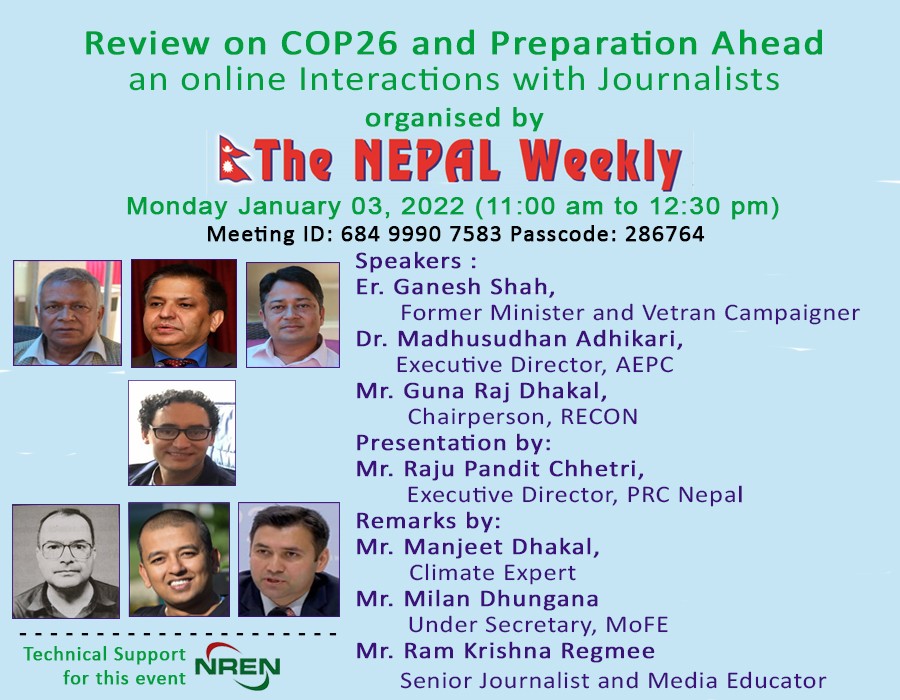 The Nepal Weekly
The Nepal Weekly  May 3, 2022
May 3, 2022By Purna N. Ranjitkar l
The local level elections all set to hold on May 13 is taking a momentum. The political parties and candidates are busy in wooing voters offering commitments for services to be rendered after being elected. They are also doing everything possible to down size the nearest competitors, mainly criticizing partisan limitations and personal weaknesses. Some top leaders are also commenting ignoring the dignity and crossing the limits of code of conduct. Their ultimate aim is to divert voters by genuine says or fake stories. They knew that that might be exposed sooner or later, even then the voters might be turned to their side.
Moreover, the manifesto issued as commitments by the main political parties are more or less similar. Their commitments are to be implemented locally with provisions of the constitution. Good governance is the common aspects all mentioned in their commitments. Gender issues, support to aged citizens, women, children, socially backward communities are also common aspects. Development of infrastructures, support to farmers, education, health facilities, employment are the common aspects in their commitments.
They indicate that they are concerned to climate change effects and need of local initiatives by introducing electric mobility and electric cooking facilities.
As the ‘federal capital’, the KMC elections have exclusive features, characteristics and importance. The mayor to be elected should be efficient and capable to suit the prestigious territory which is culturally very rich also. Moreover, the KMC mayor has to be proactive in collaborative efforts with other mayors of Kathmandu Valley to solve the common problems prevailed since long time but not successfully addressed due to lack of an appropriate coordination.
Population management, land management, safety and security of the citizens, control of air pollution, river cleaning, waste management, public transportation, health services, education, open spaces and greenery, energy management, squatters management are the common problems of all municipalities of the Kathmandu Valley. Similarly, status of federal capital along with rights and responsibilities of KMC and relevant dos and don’ts of neighbouring municipalities are also an aspects to be prepared or well informed for the would be mayors.
It is to recall that in 2018, all mayors, deputy mayors and other officials convened in the capital to jointly work to improve the air quality in the Kathmandu Valley as it is one of big problems of the common concern. The event was successful to bring the elected local authorities to understand the need of forging the fore to fight common problems as one single or a few will not be enough to bring desired result.
Most probably, this was a good beginning of working together on the common agenda. Similarly the elected authorities were naturally expected to join hands in solving other common problems
The Kathmandu Valley with an area of 360 square km is the most populated section in the country with more than 3 million. The capital valley houses central administrative bodies and the centre of all political, social and commercial activities. Most of the better medical hospitals, educational institutions are located within the bowl of 18 municipalities. This valley has historical, religious, natural and architectural landmarks. The tourists come to Nepal enjoy with its natural setting and cultural activities. People who experienced climates in various parts of the world love Nepal, specially the valley as it is neither too hot in summer and nor too cold in winter where people from any part of the globe can live comfortably in all 12 months.
The valley has never experienceda well management exercise on its capacity of natural and cultural wealth to be used in an optimised manner. Unmanaged population growths, haphazard uses of land and resources have ruined the beauty of the Kathmandu Valley in last 40 years. Due to excess human encroachment the Kathmandu Valley had turned to grey with dust and smokes from green and clean. The high raisers are uglifying the Kathmandu Valley which has already been turning to concrete jungle. Effective measures therefore sought to introduce in order to save its beauty. Urbanization may be suggested to diversify with satellite city concepts keeping in view the capacity of resources and infrastructures.
The water deposit beneath the surface has been said to be excessively pumped out without recharging in Kathmandu. The immediate solution of water shortage was somehow managed but recharging was never thought except by some serious geologists. This might bring disastrous consequence, geologists doubt.
Earthquake is another threat of the country as it had witnessed many times. The Kathmandu Valley was worstly damaged by the earthquake of 1934. The Big Earthquake of 2015 also damaged extensively in the Kathmandu Valley and neighbouring districts. The strong shocks had claimed lives and damaged of properties. Educating people on preparedness in disaster risk reduction has been slow in action. They will not find open spaces for safety if natural calamity took place. Rescue to victims will be hardly possible. The open places available in the past have been used mostly by public sector institutions erecting building structures for other than institutional purpose as well.
Thus a permanent forum of the local governments of the Kathmandu Valley may be suggested to coordinate to formulate plans and programmes to fight the common problems as well as well keeping the cultural heritage alive so as the glory of the Capital Valley will be glorified more than it enjoyed in the past. Solidarity is a need which even guides norms of administration, finance and even taxation in a harmonised manner. Moreover, strengthening of security systems should one first priority. The ongoing election season could be an appropriate occasion to consider on coordinated and collaborated efforts of the Kathmandu Valley municipalities to be organised and give the bonding a permanent status soon after installations of the elected local authorities. That will be good beginning for addressing the need of federal capital status to the Kathmandu Valley municipalities.

